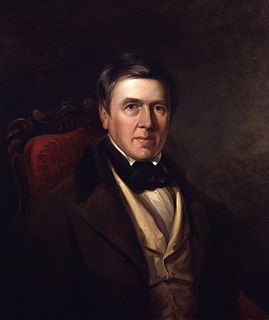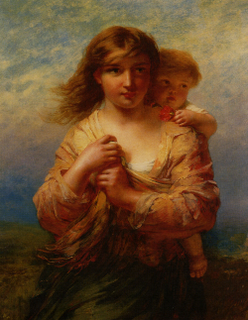
David Cox was an English landscape painter, one of the most important members of the Birmingham School of landscape artists and an early precursor of Impressionism.

Thomas Creswick was a British landscapist and illustrator, and one of the best-known members of the Birmingham School of landscapists.

Thomas Baker was a Midlands landscape painter and watercolourist often known as "Baker of Leamington" or "Landscape Baker".

Joseph Vincent Barber (1788–1838), known as Vincent Barber, was an English landscape painter and art teacher.
Joseph Barber was an English landscape painter and art teacher, and an early member of the Birmingham School of landscape painters.
Charles Vincent Barber was an English landscape painter and art teacher.

Samuel Lines was an English designer, painter and art teacher, and an early member of the Birmingham School of landscape painters.
William Radclyffe was an English engraver and painter.

Samuel Henry Baker (1824–1909) was an English landscape artist. He was a member of the Royal Birmingham Society of Artists (RBSA) and the Royal Society of Painter-Etchers and Engravers (RE). He painted rural landscape scenes in watercolour.
John Daniel Bond was an English painter. One of the earliest figures in the history of art in Birmingham, he was the first of the Birmingham School of landscape artists.

Birmingham has a distinctive culture of art and design that emerged in the 1750s, driven by the historic importance of the applied arts to the city's manufacturing economy. While other early industrial towns such as Manchester and Bradford were based on the manufacture of bulk commodities such as cotton and wool, Birmingham's economy from the 18th century onwards was built on the production of finished manufactured goods for European luxury markets. The sale of these products was dependent on high-quality design, and this resulted in the early growth of an extensive infrastructure for the education of artists and designers and for exhibiting their works, and placed Birmingham at the heart of debate about the role of the visual arts in the emerging industrial society.

Henry Harris Lines was a landscape artist and archaeologist, and the eldest son of Birmingham artist and drawing master Samuel Lines (1778–1863). There are a number of Henry's works stored in the permanent collections of various provincial museums and art galleries including Birmingham Museum and Art Gallery, Worcester City Art Gallery and Museum and the Royal Birmingham Society of Artists (RBSA) Gallery. As well as at the Birmingham Society of Arts, Henry also exhibited at the Royal Academy, British Institution and Society of British Artists. The Wright family's patronage of the Lines family is also evident in William Rostill Lines's sculpture Bust of Mr. Thomas Wright Hill that was exhibited at the Birmingham Society of Arts Exhibition in 1829.
The sheriff of the City of Cork is the court officer responsible for the enforcement of civil judgments in Cork county borough. The current sheriff is a solicitor, Martin A Harvey. Sheriffs earn their fees from poundage (commission). Before 1842 two sheriffs were voted into office annually by the freemen of the city. After that time, the power of appointment of a single sheriff per year was vested in the crown.

James John Hill, known also by his alias J. J. Hill, was an English landscape and portrait painter, known for his many rustic paintings and portraits of Lady Burdett-Coutts.

The Lines family was a family in Birmingham, England, which included several notable artists, who are considered members of the Birmingham School. These included:








